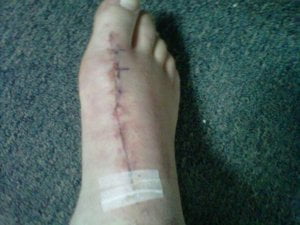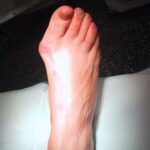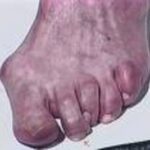On April 19th 2011, I had an hour long bunion removal surgery. My podiatrist (foot doctor) removed a wedge and some other scrapings of my right big toe. In return, my foot was given six screws and a metal plate. Soon, I get to redo the process for my other foot.
Let me start off by saying there are over a 100 types of bunion surgery ‘” each with their own details and ways about going the procedure. My sister had her surgery done where they did not remove a wedge from her toe and she only has one screw (plus the plate). Each surgery is unique. However, when looking up information on bunion removal surgeries, I know it is difficult to find the true answers to the questions.
When you go through bunion removal surgery, you can expect to be taking time off from work and walking. If you are doing the surgery on your right foot ‘” you may say good bye to driving for awhile too.
Please note ‘” that each surgery is different. Because each surgery is different the following may not be true to your scenario. This is a guideline of what happens according to my experiences through myself, my sister, my teacher, and my friend. All information gathered in this article is through one-on-one doctor time with my podiatrist and experiences of myself and loved ones.
Let’s say your surgery is on Tuesday. When you schedule your surgery your doctor should give you a cease work order. It will be good for about a week because you will need several days to get back on your feet (no pun intended). Wednesday you will be able to do small daily activities but odds are you will not be able to return to work. The day of the surgery, you may feel loopy from the anesthesia and the pain medications. Your foot will feel like it is about to pop (like a balloon). This will be minor. Day two (Wednesday) you will continue to feel fine with the pop feeling. Day three (Thursday) will be the day that your foot will start to “wake up”. Here is where you might start to feel a bit of pain or discomfort. The pop feeling will intensify. By day four (Friday) you will begin to get “used to” the discomfort and the pop feeling. Swelling will be incredibly huge.
During this time, you must get used to your crutches or scooter or whichever method of mobility you are using. You must also start to love your little black boot (see photo). The pain discomfort and the pop feeling will remain mainly due to swelling. Keep your foot elevated and ice frequently you cannot really over elevate or over ice (but do not freeze your foot entirely)!
After a week, your doctor may release you to continue working. If you had foot surgery on your left foot, he may allow you to resume driving. Recovery (being able to walk “normally”) takes about six weeks from your surgery date. If you had any complications or a more complicated surgery, it may take longer. My surgery was quite an invasive surgery and I was able to walk (limp) out of the doctor’s office at six weeks. If you have a less invasive surgery, you maybe be able to walk in the boot starting at two weeks.
Two to three weeks after surgery, your doctor will tell you to start doing foot exercises. You will have to stretch that toe regardless of the discomfort you may feel. Think of the saying “no pain, no gain”. If you do not do your exercises, you will have to go to expensive foot rehab (that most insurance companies will not cover because it was preventable). I recommend soaking your foot in warm water before doing your exercises as this loosens your joints and reduces swelling. During this time, it is imperative that you get that toe moving and keep swelling as low as you possibly can.
When you are able to walk again it is not over. You will still have over three months of swollen feet. You will want to buy “skater” shoes or wide shoes for when you walk out (and the several months afterwards). Think of it like your foot being pregnant. You will not fit in your skinny shoes for about another month or so. Your foot will ache. Your foot will feel “weird”. It will take you awhile to re-teach yourself how to walk like a normal person. It was another three weeks before I stopped limping (and was able to return to a 12 hour work shift).
Throughout this process you may realize your foot has a memory foam process going on. You can literally poke your finger into your foot, release and still have the indention of where your finger once was. This is also normal.
You will also want to make sure your foot is kept well clean and well hydrated. Your skin may develop rashes or excessive dryness. Do not add to your discomfort: wash and lotion your foot often ‘” only after your doctor allows you to.
As for costs you can expect bills to come from different places. Please keep in mind that every insurance policy and every healthcare system is unique in their billing departments. I received a bill from the anesthesiologist, the surgery center, and my podiatrist. Overall I paid about two thousand dollars. My sister paid a little less (thanks to her insurance). Keep in mind you have to pay for the surgery room, the anesthesiologist, and the screws, plates or rods they put in your foot.
The scar that will be left behind will be permanent. It will take several months for it to look “normal”. With lotion and butter oils the scar will heal faster (and look better). I strongly recommend Coconut Butter for your foot.
Tips:
- – Your foot will smell constantly. It is natural and often unpreventable.
- – Ask your doctor for a handicapped form for your car. I can promise you the long walks in the parking lot are not worth it.
- – Do your exercises exactly how your doctor tells you to: you do not want a stiff toe because that delays your walking time, your healing time, and costs you a lot more money then you will want to pay.
- – Plan ahead: tell work that you will be missing time, arrange for someone to be there to drive you post surgery, arrange for clear paths in your house, and have someone be with you the day of your surgery.
- – Do not leave the doctor’s office without a water cover for your boot (you will want it for your shower).
- – Buy shoes about a week before your “walking date” ‘” try them on often to make sure they are comfortable and that they fit!
- – A week or two before your “walking date” ‘” use your crutches to help move your leg in the walking position. Do not put weight on your foot unless your doctor says it is okay. This will help “remind” your leg the process of walking and start to regain your leg muscle.
- – Do floor leg exercises often ‘” especially for the leg with your foot. While you are no longer walking on that leg, the muscles will start to disappear making your leg sore when you return to talking.
Each bunion surgery is unique. Recovery time, costs, doctor’s orders, and all the other “perks” of having this surgery will be specialized to you. The best thing you can do for your foot is to love it and to protect it. Do not overrule your doctor for he does know what is best. And don’t forget: Exercise that toe!




